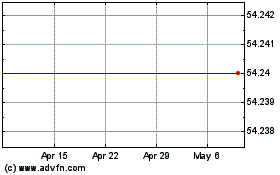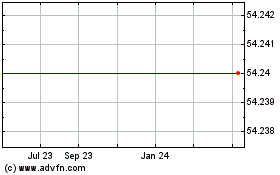(FROM THE WALL STREET JOURNAL 9/26/15)
By Vito J. Racanelli
Equities sank last week, as markets continue to be roiled by the
Federal Reserve's Sept. 17 decision to hold interest rates at zero,
and the ensuing uncertainty about the timing of a rate rise.
The broad market fell 1.4%, with the selloff intensifying
Friday, when biotech stocks tumbled sharply in the afternoon. There
was no particular catalyst beyond the deterioration in sentiment
and a desire by some investors to take down exposure to riskier
assets, like small-caps and biotechs, traders say.
Affirmation of a hike this year by Fed Chair Janet Yellen -- in
a speech after the market closed Thursday -- gave stocks a brief
boost Friday, but the impetus petered out. Additionally, a strong
earnings report from Nike (ticker: NKE), a component of the Dow
Jones Industrial Average, pushed the Dow to a gain on Friday.
Last week, the Dow lost 0.4%, or 70 points, to 16,314.67, and
the Standard & Poor's 500 index fell 1.4%, or 27, to 1931.34.
The Nasdaq Composite dropped 3% to 4686.50.
The market is suffering from the aftershocks of the Fed's
decision, says David Lefkowitz, senior equity strategist at UBS
Wealth Management Americas: "It's still trying to digest what the
Fed is trying to communicate."
In her remarks, the Fed chair suggested overseas developments
wouldn't be important enough to have an impact on the decision to
hike later this year, seemingly backpedaling from the Fed's
previous statement.
From week to week, the Fed's message seems to be different,
creating uncertainty, adds Rick Seto, a managing director at
Flaherty & Crumrine. Investors need greater clarity to make
fundamental investment decisions. "The only people making money now
are day traders," he adds.
"The U.S. is not a zero fed-funds-rate economy now," says David
Seaburg, head of sales trading at Cowen. Friday, the Commerce
Department revised its estimate of second-quarter
gross-domestic-product growth to 3.9% from 3.7%. The fed funds rate
-- the overnight lending rate banks charge one another for funds
maintained at the Fed -- is currently 0% to 0.25%.
"Rate liftoff would give confidence in the American economy. The
Fed needs to move in December," Seaburg says.
One bright spot was Nike, whose shares rose 9% Friday to $125.
After the close Thursday, the giant sportswear maker posted a 23%
jump in quarterly profit and a 5% rise in revenue, with sales gains
of 30% in China. That partly assuaged worries about a Chinese
economic slowdown. Markets don't fully trust the official economic
data coming out of China, so Nike's figures are a boost to
confidence about the Middle Kingdom.
The market is probably in for more seesaw action through
seasonally weak October. "People forget that when the Fed started
this extraordinary monetary-policy ease it was bumpy going in. It's
going to be bumpy coming out," says Keith Bliss, director of sales
at broker-dealer Cuttone.
This week sees at least two important September data points: the
ISM manufacturing report, out Thursday, and Friday's U.S.
employment report.
Boring Is Beautiful at BB&T
In times of market turmoil, "boring" stocks become more
interesting. Regional bank BB&T is one of those stocks. The $27
billion market-cap company is a steady eddie, a well-run southeast
regional bank whose shares have traditionally been attractive to
income-seeking investors with a long-term outlook. More's the case
now.
The stock (BBT) is down, along with other financials, by 15%
this year, to $35.68 from a high near $42. The shares, which yield
3%, could approach the old high over the next two years, as
earnings growth improves. That would mean a double-digit annual
total return, even if the market continues to bounce around. As
with all banks, higher interest rates would help, but this bank is
more diversified than investors seem to realize and has other
levers that should help grow profits next year.
Financials are down because the Federal Reserve's intention of
raising rates has moved much more slowly than the market has
expected. Banks in particular have fallen harder than the market
since its swoon began in mid-August.
Higher rates would help boost net interest margins -- the
difference between the interest paid on deposits and what the bank
gets on loans -- and push up profits. BB&T's margin has
suffered quarter after quarter, just as at other banks. "BB&T
gets lumped in with other traditional banks, but it isn't as
sensitive to rates as most regionals are," says Robb Parlanti, a
portfolio manager at Burke Lawton Brewer & Burke Financial
Advisors. The firm has been buying BB&T shares for clients.
Traditional branch banking makes up just 44% of BB&T's net
income, with the rest divided among mortgages, car loans,
commercial lending, insurance, and wealth management.
Parlanti also likes that BB&T is a growth story. The
Winston-Salem, N.C. --based bank has been expanding its footprint
with recent acquisitions in Pennsylvania, for example. Growth
through acquisition can be risky, but BB&T has a strong track
record of accretive growth through relatively small, bolt-on
acquisitions. The bank has proven itself adept at cutting costs,
taking share in new markets, and growing earnings this way,
Parlanti adds.
Analysts expect BB&T to earn $3.28 per share next year, up
from an estimated $2.67 this year, as the bank fills out its
footprint, thanks partly to additions in Kentucky and Pennsylvania.
In 2014, BB&T earned $2.75.
The price/earnings ratio, at 11 times forward EPS, is
undemanding, considering its median P/E is 13. Earnings growth has
been lumpy, but the bank has been consistently profitable, even
through the 2008-09 financial crisis. BB&T earns a better
return on assets, 1.16%, than the 1.07% average of its peers,
according to Bloomberg. It's ROA is also higher than other
well-known regionals, including Fifth Third Bancorp (FITB) and
KeyCorp (KEY).
"BB&T is a well-managed tight ship," Parlanti adds, with
loan losses and nonperforming assets moving down steadily since
2010. Given a dividend that's grown an average 10% since 2010, ". .
.it's a nice stock to have in a diversified bank portfolio."
BB&T stock won't be a moon shot. But with the way the
market's acting and the prospect of more of the same, it doesn't
have to be in order to make investors happy.
Demandware's Danger
Demandware (DWRE) is as sexy as BB&T is boring. The
Burlington, Mass.-based company sells cloud-based services to
retailers and consumer-brands companies, for the most part. Its
products and software are used by companies to develop and manage
e-commerce across various platforms, including online, in-store,
mobile, and social networking.
E-commerce sales are expected to grow about 20% annually through
2018. Demandware, whose products are well respected, is growing
faster yet, with annual revenue up an average of 50% over the last
five years, to $160 million in 2014 from $21 million.
What Demandware lacks, however, after nearly a decade in
business and three as a publicly traded company, are profits,
though analysts forecast $8.6 million next year. Investors should
beware all the same. Even after falling from $76 in July to a
recent $52.17, shares trade at a sky-high 233 times projected
earnings.
Losses have widened steadily, to 78 cents per share last year
from 23 cents per share in 2012. The first half of 2015 has been no
better, with a loss of 71 cents versus 49 cents in the year-ago
period. The figures are based on generally accepted accounting
principles.
And Wall Street's 2015 projections seem optimistic, given they
have consistently proved too bullish since the company came public
at $16 in March 2012. There's no reason to think the profit-poor
situation has changed. Moreover, the consensus uses adjusted
non-GAAP EPS, leaving out various noncash expenses, such as
stock-based compensation packages, which are substantial at
Demandware. That's common enough for high-tech companies, but these
compensation costs aren't going to let up any time soon. As of Dec.
31, there was another $62 million in yet-to-be-recognized stock
compensation due over the next three years.
Demandware's other expenses are lately outpacing sales. In the
second quarter, subscription sales rose a blistering 45% from a
year ago, but costs grew at a 60% clip.
Demandware gets the great majority of its revenue based on a
subscription model, taking a small percentage of customer sales
over its platforms. It relies heavily on its ability to add new
clients and create new services to further integrate clients into
its system. But attracting new customers and developing new
features has been increasingly expensive for Demandware, says David
Trainer, president of New Constructs, an independent accounting
research firm.
The market eventually wants profits, but given intensifying
competition, it's hard to believe Demandware will generate as much
as is already discounted by the high share price, says Trainer, who
calls the stock significantly overvalued. Deep-pocketed rivals
include IBM (IBM), Oracle (ORCL), eBay (EBAY), and SAP (SAP), among
others, want a piece of this growing industry. So how would cost
growth subside much? Moreover, Demandware is the lower-price
alternative and has less to give on margins.
Some key metrics have slowed. Annual customer growth fell to 31%
last year from 35% in 2013 and 50% in 2012. The backlog increase
dropped to 37% last year from 67% in 2013. While many companies
would love these numbers, the trend is going the wrong way for
Demandware's valuation.
The stock is vulnerable to another quarterly miss. Part of the
drop seen so far was due to a second-quarter EPS miss, when shares
fell 12%. Average subscriber revenue grew 4% in the last quarter
from the year-ago period, much less than the 13% average of the
previous five quarters. That could mean Demandware is signing up
smaller customers, or prices are eroding.
Demandware did not respond to a request for comment.
(MORE TO FOLLOW) Dow Jones Newswires
September 25, 2015 19:52 ET (23:52 GMT)
Copyright (c) 2015 Dow Jones & Company, Inc.
BB and T (NYSE:BBT)
Historical Stock Chart
From Mar 2024 to Apr 2024

BB and T (NYSE:BBT)
Historical Stock Chart
From Apr 2023 to Apr 2024
